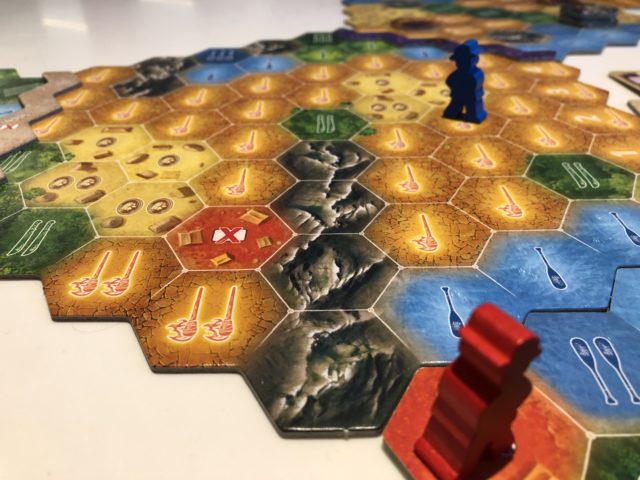(No dad-joke subtitle this week: the actual title is long enough as it is.)
As a person of a certain age I always find it cheering when an artist creates something original and worthwhile later in their career. Like David Crosby’s or The Who’s recent albums. Or Matisse’s cut-out works. Or Frank Lloyd Wright’s Guggenheim Museum.
Or the esteemed Doctor himself, Reiner Knizia, whose 2017 game The Quest For El Dorado (QfED hereinafter) reminded me how amazing he can be at taking a simple set of rules and twisting it that little bit to make a game with elegance, depth, and replayability. (See my original review here.)
QfED is a race game with deckbuilding as its core mechanic. The first player to get to El Dorado wins–that’s it, no matrix-multiplication mini-max scoring. The modular board can be assembled any which way you choose, and aside from the six provided in the box, one BGG user went through the trouble of curating 70 other maps if you’re too lazy to do it yourself.

The only downside was that all possible cards were eventually available in every game. Expansions please! Luckily the first one, Heroes and Hexes (HaH) came out only a year later, adding new map tiles riddled with nasty demon hexes that required explorers to take on curses upon entry. But never fear, there were several allies and items which could deal with those if you took the trouble to acquire them. HaH also added some asymmetry by starting each player off with their own unique Familiar card in their deck that gave you decent utility until you decided to trash it later in the game for one last glorious boost. Players also had the opportunity to stop off at the Tavern to hire from a selection of OP heroes that allowed for further deck customization. All well and good.
Now the standalone-and-sequel The Golden Temples (TGT) has dropped. The biggest change is that before entering the final crypt hex (thus clinching the game), players must first visit three temples to acquire a gem from each. Each temple is two-sided, which (as one has come to expect from this series) provides for plenty of variety in terms of what you need to enter them.
This scavenger hunt breaks with the linearity of the base game, allowing players to decide which temple to visit first. With two or three players this means a lot less potential for blocking (since explorers cannot pass through each other); each player can head for a different temple to start with and generally avoid each other. With four players, though, you’re going to be bumping into each other more.

Naturally there are also new modular tiles, which add a new major terrain type (torches), as well as a new map feature called a Guardian which activates when you move next to it. Guardians are the most explicitly Euro-ish feature I’ve seen in a Knizia game, since each provides a catch-up bonus for everyone BUT the person who activates it.
Finally, there are physical coins which can be earned and spent in a variety of different ways and which provide for some new deckbuilding possibilities in the new ally and item cards.
On its own, TGT is perfectly fine, and some might prefer it to the base game as a standalone. But I have been diving into epic scenarios combining all three games and let me tell you, if QfED or TGT on their own is a light snack, then putting all three together is a hearty meal, a veritable Transylvanian Wooden Plate that can last 2+ hours.

Everyone begins with a QfED starter deck and the market also starts with the six base game choices. Additional cards are introduced in a two-step system. At game’s start you assemble a randomizer deck drawn from all the other cards in the three games. You pull twelve cards to set up what I’ll call “on-deck” piles. The first time a player swaps in one of the on-deck piles to fill an empty slot in the market you draw a new card from the randomizer deck and add that pile to the on deck piles. (It sounds way more complex than it actually is. It’s also a pain to set up and take down at the end of the game and I assume/hope someone will appify the process before long.)
In these epic quests you have to navigate through very different terrains so it’s crucial that most of your deck consists of cards that have multiple uses. Each leg is a mini-puzzle you have to optimize, and what works best changes from tile to tile. The market card system means you have to move fast to grab the cards that work the best with the terrain in front of you or else you’re stuck unless or until a good card turns up in the “on-deck” circle. Luckily, there are usually many solutions to any given issue–but sometimes one is simply better than others, and since there are only three copies of any given card you can get frozen out.
I don’t know if Knizia envisaged the whole combo when he started working on it, but if he did then he went about it the right way, introducing the base mechanics first then layering on the other bits bit by bit. I sort of hope Knizia leaves things off here, because everything is just manageable together and adding more might just tip things over into the “too-long-for-what-it-is” category.
I’m glad to see others have also started to call QfED a “classic”, and I heartily recommend The Golden Temples both as a standalone and as a sequel.
Thanks to Ravensburger Games for supplying a copy of The Quest For El Dorado: The Golden Temples for this review.
Comments
No comments yet! Be the first!